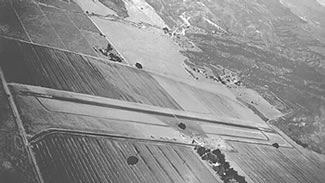BUSINESS
Inside SCV History
A Generation of Veterans Inspires New Home Development and Lays Groundwork for Santa Clarita
August, 2006 - Issue #22
 Photo courtesy of Santa Clarita Valley Historical Society/SCVHISTORY.COM |
During the war, the rationing of metals and labor had hampered the growth of oil exploration across the valley. Buying retail, there simply wasn't enough market supply to expand the oil exploration operations despite the necessity for oil to feed the demands of war. To solve this problem locally, Rancher's Supply, a wholesale supply store, opened its doors near the intersection of Ventura Highway (Route 126) and Highway 99 (Interstate 5). Now flush with the necessary metal pipe, production soared towards the end of the war.
With the close of hostilities in Europe and the Far East, there was suddenly a major shift in American culture. Millions of men returned home, many seeking education from a growing number of institutes of higher education thanks to the Montgomery GI Bill. Demand for housing and employment rose exponentially, as well.
Never missing an opportunity, the Newhall Land company began considering the development of a self-contained city near Castaic Junction. But even as high as the demand for housing was, there were certainly elements of resistance within the board of directors. A few of the members wanted to keep the land as it has been during previous generations, mostly agriculture and ranching. The Los Angeles County Assessor policy of taxing land at is highest possible value, usually residential or commercial, silenced this minority. There were still holdouts, however, who feared that development might cover untapped oil fields. Working forth a compromise, all future developments were approved only after substantial search by expert geologists declared the area to be oil free. Still, most developments in addition to being constructed with easements for landscaping and infrastructure contained open plots of land where drilling could resume should any oil be discovered at a later date.
All the talk of development finally turned into action with the purchase of more than 300 acres by William Bonelli in mid-1948. His purchase at the corner of San Fernando and Soledad Canyon Roads would eventually include the Saugus Speedway and the valley's first tract development in Seco Canyon (which is Spanish for Dry Canyon).
Though there were pockets of development in Newhall and Castaic at the time, the 55-home tract along Seco Canyon would be the first true development in the valley. It was also the first use of the term Santa Clarita, the formal name for the tract, though it was commonly called the Bonelli tract as well, as it was the first to use the modern technique of prefabrication. Wells bored into Bouquet Canyon provided the water for the homes while students traveled across town to the newly opened Hart High School for their studies.
In April 1950, the board of directors heard a presentation by Elmore Hutchinson about the feasibility of a city centered at Castaic Junction. With a proposed 83,000 residents, the city would take advantage of the massive influx of interest in California by both residents and businesses. The future of Santa Clarita began to crystallize in cement as development began to flood forth.
--------------------------------------------------------------
Much of the research for this article came from "A California Legend: The Newhall Land and Farming Company" by Ruth Waldo Newhall.
|
||||||||||||||||||||||||||||





